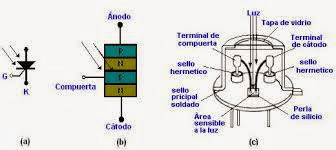Constructions of LASCR:

The basic construction of light activated silicon controlled rectifier (LASCR) is shown in above fig.
The LASCR is a semiconductor electronic switch which has a lens that focuses light on its gate. It is triggered into conduction by light. If sufficient light does not fall on the LASCR then it remains in off state.
Working of LASCR:
The incident photons will generate electron hole pairs, when light is focused on LASCR (light activated silicon controlled rectifier).
The number of optically generated electron hole pairs is proportional to the intensity of light. These electrons will constitute a gate current for LASCR and due to the internal current multiplication.
The LASCR is latched into ON state. The LASCR is most sensitive to light when its gate terminal is left open. Its sensitivity can be reduced and controlled to some extent by inserting a resistor between its gate and cathode terminals.
It offers complete electrical isolation between the triggering source and the switching device. The forward breakdown voltage decreases with increase in light intensity.
